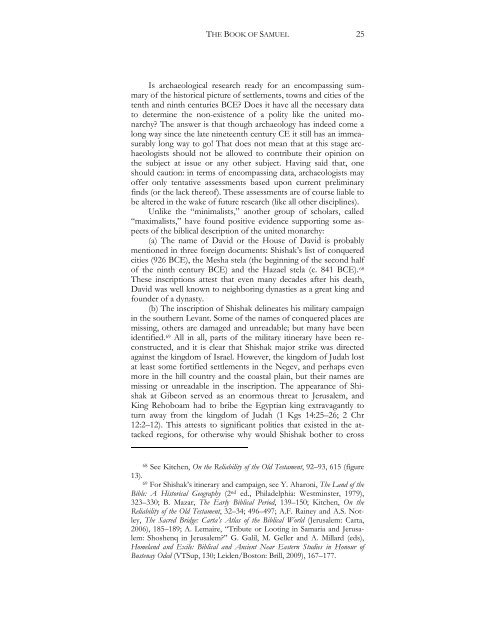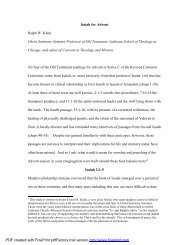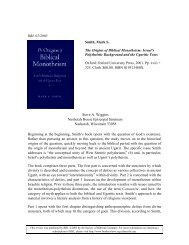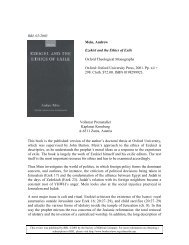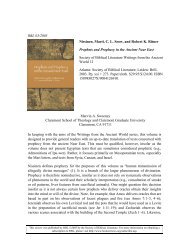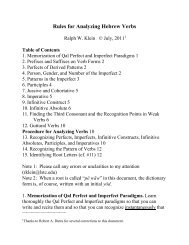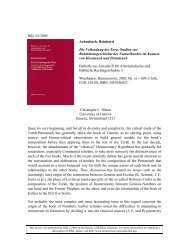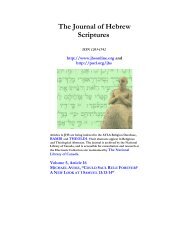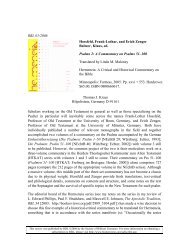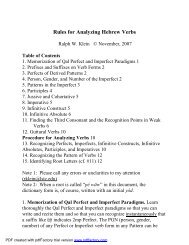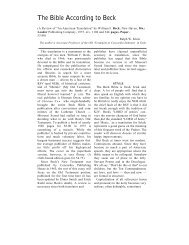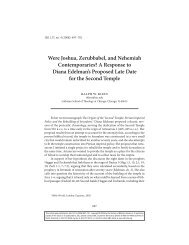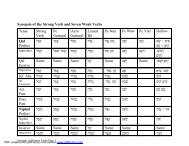The Book of Samuel: Its Composition, Structure and Significance as ...
The Book of Samuel: Its Composition, Structure and Significance as ...
The Book of Samuel: Its Composition, Structure and Significance as ...
Create successful ePaper yourself
Turn your PDF publications into a flip-book with our unique Google optimized e-Paper software.
THE BOOK OF SAMUEL<br />
Is archaeological research ready for an encomp<strong>as</strong>sing summary<br />
<strong>of</strong> the historical picture <strong>of</strong> settlements, towns <strong>and</strong> cities <strong>of</strong> the<br />
tenth <strong>and</strong> ninth centuries BCE? Does it have all the necessary data<br />
to determine the non-existence <strong>of</strong> a polity like the united monarchy?<br />
<strong>The</strong> answer is that though archaeology h<strong>as</strong> indeed come a<br />
long way since the late nineteenth century CE it still h<strong>as</strong> an imme<strong>as</strong>urably<br />
long way to go! That does not mean that at this stage archaeologists<br />
should not be allowed to contribute their opinion on<br />
the subject at issue or any other subject. Having said that, one<br />
should caution: in terms <strong>of</strong> encomp<strong>as</strong>sing data, archaeologists may<br />
<strong>of</strong>fer only tentative <strong>as</strong>sessments b<strong>as</strong>ed upon current preliminary<br />
finds (or the lack there<strong>of</strong>). <strong>The</strong>se <strong>as</strong>sessments are <strong>of</strong> course liable to<br />
be altered in the wake <strong>of</strong> future research (like all other disciplines).<br />
Unlike the “minimalists,” another group <strong>of</strong> scholars, called<br />
“maximalists,” have found positive evidence supporting some <strong>as</strong>pects<br />
<strong>of</strong> the biblical description <strong>of</strong> the united monarchy:<br />
(a) <strong>The</strong> name <strong>of</strong> David or the House <strong>of</strong> David is probably<br />
mentioned in three foreign documents: Shishak’s list <strong>of</strong> conquered<br />
cities (926 BCE), the Mesha stela (the beginning <strong>of</strong> the second half<br />
<strong>of</strong> the ninth century BCE) <strong>and</strong> the Hazael stela (c. 841 BCE). 68<br />
<strong>The</strong>se inscriptions attest that even many decades after his death,<br />
David w<strong>as</strong> well known to neighboring dyn<strong>as</strong>ties <strong>as</strong> a great king <strong>and</strong><br />
founder <strong>of</strong> a dyn<strong>as</strong>ty.<br />
(b) <strong>The</strong> inscription <strong>of</strong> Shishak delineates his military campaign<br />
in the southern Levant. Some <strong>of</strong> the names <strong>of</strong> conquered places are<br />
missing, others are damaged <strong>and</strong> unreadable; but many have been<br />
identified. 69 All in all, parts <strong>of</strong> the military itinerary have been reconstructed,<br />
<strong>and</strong> it is clear that Shishak major strike w<strong>as</strong> directed<br />
against the kingdom <strong>of</strong> Israel. However, the kingdom <strong>of</strong> Judah lost<br />
at le<strong>as</strong>t some fortified settlements in the Negev, <strong>and</strong> perhaps even<br />
more in the hill country <strong>and</strong> the co<strong>as</strong>tal plain, but their names are<br />
missing or unreadable in the inscription. <strong>The</strong> appearance <strong>of</strong> Shishak<br />
at Gibeon served <strong>as</strong> an enormous threat to Jerusalem, <strong>and</strong><br />
King Rehoboam had to bribe the Egyptian king extravagantly to<br />
turn away from the kingdom <strong>of</strong> Judah (1 Kgs 14:25–26; 2 Chr<br />
12:2–12). This attests to significant polities that existed in the attacked<br />
regions, for otherwise why would Shishak bother to cross<br />
68 See Kitchen, On the Reliability <strong>of</strong> the Old Testament, 92–93, 615 (figure<br />
13).<br />
69 For Shishak’s itinerary <strong>and</strong> campaign, see Y. Aharoni, <strong>The</strong> L<strong>and</strong> <strong>of</strong> the<br />
Bible: A Historical Geography (2nd ed., Philadelphia: Westminster, 1979),<br />
323–330; B. Mazar, <strong>The</strong> Early Biblical Period, 139–150; Kitchen, On the<br />
Reliability <strong>of</strong> the Old Testament, 32–34; 496–497; A.F. Rainey <strong>and</strong> A.S. Notley,<br />
<strong>The</strong> Sacred Bridge: Carta’s Atl<strong>as</strong> <strong>of</strong> the Biblical World (Jerusalem: Carta,<br />
2006), 185–189; A. Lemaire, “Tribute or Looting in Samaria <strong>and</strong> Jerusalem:<br />
Shoshenq in Jerusalem?” G. Galil, M. Geller <strong>and</strong> A. Millard (eds),<br />
Homel<strong>and</strong> <strong>and</strong> Exile: Biblical <strong>and</strong> Ancient Near E<strong>as</strong>tern Studies in Honour <strong>of</strong><br />
Bustenay Oded (VTSup, 130; Leiden/Boston: Brill, 2009), 167–177.<br />
25


